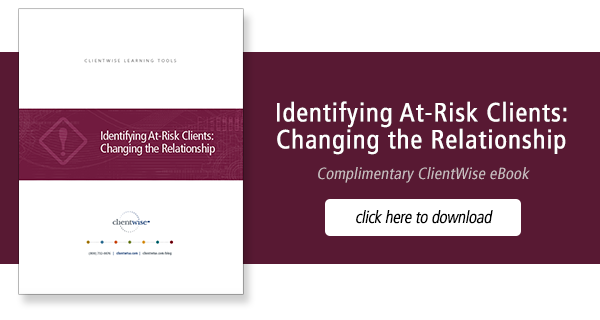Wealth Management Advisors: Identify Your At-Risk Clients
 Lately, in talking with financial advisors, I’m getting a sense that clients have finally settled down a bit after the heightened volatility that ushered in the New Year. Enough positive economic news along with abating fears about a China meltdown have served to calm the waters enough to fuel a bounce back that made quarterly statements a lot more palatable to mail.
Lately, in talking with financial advisors, I’m getting a sense that clients have finally settled down a bit after the heightened volatility that ushered in the New Year. Enough positive economic news along with abating fears about a China meltdown have served to calm the waters enough to fuel a bounce back that made quarterly statements a lot more palatable to mail.
Even despite one of the presidential candidate’s efforts to open a proverbial bag of snakes with pronouncements that “a massive recession” is looming, my sense is that most of your clients are back and becoming increasingly engaged. This may be an opportune time to pause and assess any relationship damage that may have occurred over time.
Many of the best financial advisors accomplish this objectively by segmenting their client roster by relationship at-risk characteristics. Most of you already segment your clients based on a multitude of factors. You build A, B, and C books based on assets, revenue, profitability and required time. You group clients by services utilized, referral sources, and various hobbies, interests and associations. However, very few advisors make an effort to segment their clients based on something as unpleasant as the likelihood of a client walking out the door.
Conducting an At-Risk Client Assessment
Trust me; I know it’s a rather unpleasant task – something akin to finding out what congealed gunk is lurking underneath your refrigerator – but it’s essential to the continued health and future growth of your practice. We suggest you begin by segmenting your client base into four categories:
-
Client Advocates – the small subset of clients who consistently make 3-4 or more introductions every year; both they and their families are fully-engaged with your wealth management team and actively advocating for you within the community whenever opportunities present themselves.
-
Engaged Clients – hopefully, the lion’s share of your clients; they show up for meetings brimming with interest and questions; they’ve been with you forever and likely will be for generations thanks to family engagement; perhaps they make a referral here and there, but not as frequently or automatically as your advocates; they’re stable, solid and profitable clients that you enjoy working with; your ideal firm would have 100 more just like them.
-
Questionable Clients – these are the clients who suddenly aren’t as responsive as they once were; perhaps there was a wrinkle or a bump in the relationship where someone on the team dropped the ball but the issue was ultimately resolved; you’re just not really sure where you stand and whether there’s any lingering resentment; if you suggest involving their spouse or kids they may balk at the request; in all likelihood, you’re probably renting the relationship until such time as you get an ACAT transfer request because the client didn’t have the courage to vocalize their dissatisfaction and chose to simply move the account instead.
-
At-Risk Clients – these are the clients who you know are angry; perhaps they’ve even told you how disappointed and dissatisfied they are and that they’re considering moving their relationship to another advisor; maybe they’re dissatisfied with their financial plan, their investment portfolio or the performance of their life insurance product; maybe you’ve had a lot of turnover on your team and they’re upset with the revolving door of people they’ve had to get up to speed and deal with; they’ve likely been shuffled around and feel like an orphan account.
After all the volatility of the first quarter, this is an opportune time to sit down with your team and objectively assign each of your clients to one of these four categories. Then look critically at your client communications procedures and client engagement process for meaningful ways to better connect with and engage those clients who fall into the questionable and at-risk categories. Even small incremental improvements can re-engage a client who might otherwise have walked away.
Granted, you will always have a certain percentage of clients who feel compelled to seek out greener pastures. And in some of those cases, there’s little if anything that can be done to prevent their departure. However, it’s important to never lose sight of the fact that the effort required to salvage an existing relationship is typically far less than that which is required to establish a completely new one.
 Coaching Questions from this article:
Coaching Questions from this article:
-
What strategic steps can you commit to taking to more proactively engage questionable and at-risk clients to start developing them into engaged clients?
-
When conversing with clients, how much time do you spend discussing the services you provide rather than the challenges you could help them overcome? What steps can you take to shift the conversation?
-
What tactics can you employ to explore uncomfortable topics or awkward situations with your clients in a way that makes them feel safe and cared for?
Topics: Client Engagement


